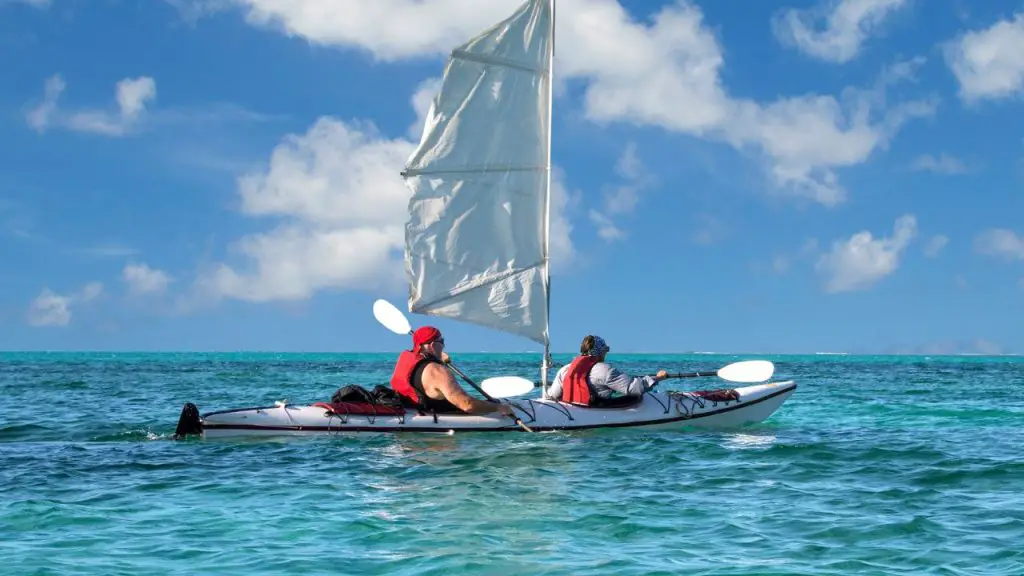How much does a tandem kayak weigh? The weight varies significantly from one kayak brand and model to the next. But the average tandem kayak is about 65 pounds. However, expect that value to shift to either side.
The kayak’s weight depends on the type, size, and construction material. A recreational kayak can weigh 35 pounds if for single-person use. On the other hand, fishing kayaks tend to be heavier, weighing up to 120 pounds.
But what affects the kayak’s weight, and why does it matter? Read on to find out!
Table of Contents
How Much Does a Tandem Kayak Weigh?

The weight of a tandem kayak depends on many factors. It varies from one kayak to the next. So, you should cross-check the tandem kayak’s weight before buying.
Most tandem kayak weights fall between 50 pounds (22.6 kg) and 78 pounds (35 kg). A double or tandem kayak should weigh about 65 pounds (29 kg).
Also, the weight of a double or tandem kayak depends on the manufacturer. Different brands have different weight standards, which also depend on the size and material used in the construction.
Check out the following chart for the weight of some popular tandem kayaks to give you an idea of what to expect.
| Models | Length(feet) | Width (inches) | Material | Weigh |
| Ocean Kayaks Malibu Two Tandem Weight | 12ft | 34 in | Single Layer Polyethylene | 63 lb (29kg) |
| Tribe 13.5 Tandem | 13.5 ft | 33.7 in | Single Layer Polyethylene | 67 lbs (30 kg) |
| MALIBU TWO XL | 13 ft | 34 in | Single Layer Polyethylene | 70 lb (32 kg) |
| Sun Dolphin Kayaks Bali 13.5 SS Tandem Weight | 13.4 ft | 35 in | High Density Polyethylene | 70lbs. (32kg) |
| Pelican Kayaks Sentinel 130X Tandem Weight | 13 ft | 34 in | RAM-X™ polyethylene | 73 lbs. (33kg) |
| Perception Kayaks Rambler Tandem – 13.5 Weight | 13.6 ft | 34 in | High-Density Polyethylene | 78 lbs. (35kg) |
But how do you know how much a double kayak weighs? You can do that in different ways. First, go to the manufacturer’s website and read the specifications for the tandem kayak model.You will find its weight and other information, such as length and width, listed on the website.
Perception Tribe 13.5 Sit on Top Tandem Kayak
If the first option does not help, check it out with the store where you bought your tandem kayak. The seller likely has the product specifications in the catalog received from the manufacturer.
The last option is to weigh the kayak yourself. For that, you need a weighing scale that can accommodate the weight of the largest double kayak. Check the weight limit of the weighing scale you intend to use before carrying out that task.
What Affects Tandem Kayak Weight?

The kayak’s weight depends on the construction material and its size. But remember that the material determines the kayak’s durability and, to some extent, performance. Let’s break it down to understand how these factors influence the kayak’s weight.
Material
A kayak can be made with the following materials:
- Rotomolded
- Thermoformed plastic
- Fiberglass/composite
- Vinyl
- PVC
- Hypalon/Nitrilon
Each material listed above has unique strength, weight, and corrosion resistance. In this case, we will only emphasize what each material weighs and how it impacts the overall weight of a tandem kayak.
Rotomolded kayaks: are made of solid, one-piece plastic. Such kayaks are the most affordable and the heaviest to transport and paddle. If you are looking for something more lightweight, go for thermoformed kayaks.
Thermoformed kayaks: are constructed using two separate layers. Their weights compare to fiberglass composite kayaks and are as durable as one-piece rotomolded kayaks. They are also relatively affordable and versatile, the best choice for novice paddlers.
Fiberglass, Kevlar, and graphite composite: a reliable material for kayak construction. It is lightweight, and the resulting kayaks have better performance in water than rotomolded ones. However, these kayaks are more expensive.

Vinyl: mainly used in making affordable inflatable kayaks. Such kayaks are constructed from a thin layer of vinyl stitched together to trap air. Some are encased in UV-light protective fabric to increase durability. They are the lightest material, resulting in the lightest kayak type.
PVC: a specific type of vinyl also used for inflatable kayak construction. PVC kayaks are on the lightest end of the weight spectrum.
Hypalon/Nitrilon: constructed from a layer of synthetic material and woven fabrics. Kayaks made from these materials are relatively light but expensive. Manufacturers often mix the two materials to keep the cost low. On the positive side, kayaks constructed from Hypalon and Nitrilon are durable and resist many extreme weather elements.
Size
How size affects the weight of a kayak is easy to figure out. Shorter or smaller kayaks are lighter than longer ones. Large kayaks take more construction material, which affects the overall weight. If you are after weight, do not buy a kayak bigger than you want.
Why Does Kayak Weight Matter?
Weight is not something that everyone would like to carry. Even weightlifters have a routine to do it. So, the weight of your kayak is crucial for easier handling. It should be something you can easily manage without external assistance.
Choose a kayak you can load and offload from your car’s roof or launch when you get to the water. The intended purpose for your kayak should guide you on the weight that will suffice. The golden rule is to leave room for extra weight to enhance the versatility of your boat.
Your kayak’s weight determines its buoyancy. Smaller and shorter boats float better on water but support less cargo weight. That is why you find fishing kayaks much heavier than tandem kayaks. They are intended to carry fishing gear and the catch after a whole day of fishing.

The weight of a kayak also determines its stability in water. The lightest ones are the least stable and are challenging to paddle even through small waves and tides.
Lastly, the cargo space determines how much your kayak weighs. The smaller it is, the smaller and lighter the boat will be. If you intend to carry more cargo aboard, go for a slightly heavier kayak.
What Is the Maximum Weight That a Tandem Kayak Can Hold?
The weight-carrying capacity of a kayak depends on many factors, but the primary one is the boat’s size. The bigger your kayak is, the more cargo you can fit in, and it remains afloat and stable on the water.
Most double or tandem kayaks carry between 400 pounds to 600 pounds. However, remember that the more the boat can hold, the larger and heavier it will be. So, you should consider how you will carry it around. Consider the ideas in the section below.

Ideas to Transport a Tandem Kayak
How you transport your kayak from place to place has a significant effect on its lifespan. You should choose safe methods that also do not take much of your time and resources. Consider the following ideas:
- Kayak cart: helps to move the kayak safely and effortlessly from place to place. It is the preferred method for moving kayaks over short distances.
- Roof rack: you can turn your vehicle into a reliable kayak carrier by mounting a roof rack on top. You can carry one or two kayaks at once on a roof rack and relatively over a long distance.
- Truck or kayak trailer: the best of your truck is a safe place for transporting a kayak over a long distance. But if you don’t own one, buy a kayak trailer.
In the above cases, you may need a helper to load a kayak if it is heavy. Loading and securing a kayak on a roof rack is the most challenging and nearly impossible for one person to handle.
Multi-Sport Multi-Rack Kayak Trailer
Tandem Kayak Vs. Single Kayak – Which Is Heavier?
A tandem kayak is slightly heavier than a single kayak because it is roomy and designed to carry two people. A paddler and passenger can fit in a tandem kayak without compromising its performance in the water.
In other words, the weight variation should not be a big deal if you plan to carry two people in your tandem kayak. It remains the best choice.

FAQs
How much does a 14-foot kayak weigh?
The expected weight of a 14-foot kayak is about 68 pounds. But recreational kayaks can weigh as low as 45 pounds or as high as 87 pounds. So, it pays to spend time identifying the appropriate kayak weight for your application.
How much do most kayaks weigh?
The average weight for a recreational kayak is 35 pounds for a single kayak. A tandem or double kayak weighs 65 pounds. Fishing kayaks are found on the high end of the weight spectrum, weighing over 120 pounds.
Is a 50 lb kayak heavy?
No. 50 pounds weight is the average for many kayak types, though many models can weigh more. For example, the average weight of a tandem kayak is 65 pounds.
How much does a double ocean kayak weigh?
Double ocean kayaks tend to be heavier. Their weight typically ranges from 65 pounds to 75 pounds. They are relatively larger and can carry 2-3 people.
Is a heavier kayak more stable?
Yes. A heavier kayak sits more inside the water, which makes it stable. It is less swayed by wind and water currents than lightweight ones. You can easily paddle it in a straight line in different water conditions.
How much does a Malibu two kayak weigh?
A 12-foot Malibu two kayak weighs 57 pounds and has a weight carrying limit of 362 pounds. As hinted, this double kayak measures 12 feet long and 3 inches wide. It is stable and versatile and can seat one or two people.
Is a lighter kayak better?
A lighter kayak is not necessarily better. It all depends on the intended use. Lighter is not better if you want to carry heavy or more cargo. It is also less stable and often affected by wind and water currents. However, a light kayak is easy to transport and ideal for recreational purposes.
How do you transport a kayak?
Many ways of transporting a kayak exist. You can load it on a roof rack, truck bed, or kayak trailer. There is also a kayak cart. This is ideal for moving your kayak over short distances, especially from your vehicle to the water to launch it.
Conclusion
The average weight of a tandem kayak is 65 pounds, but you can get heavier or lighter models. The kayak’s weight determines its cargo-carrying capacity, stability, performance, and portability. Lighter ones are easier to move around. However, they are less stable and carry less cargo. So, take time to choose a kayak with a weight appropriate for the intended application.
Thank you for reading this article at Windpaddle. We appreciate your time and ask you to kindly share it with your fellow paddlers to help us reach more people and to enlighten them. You can also explore the site for related content.


